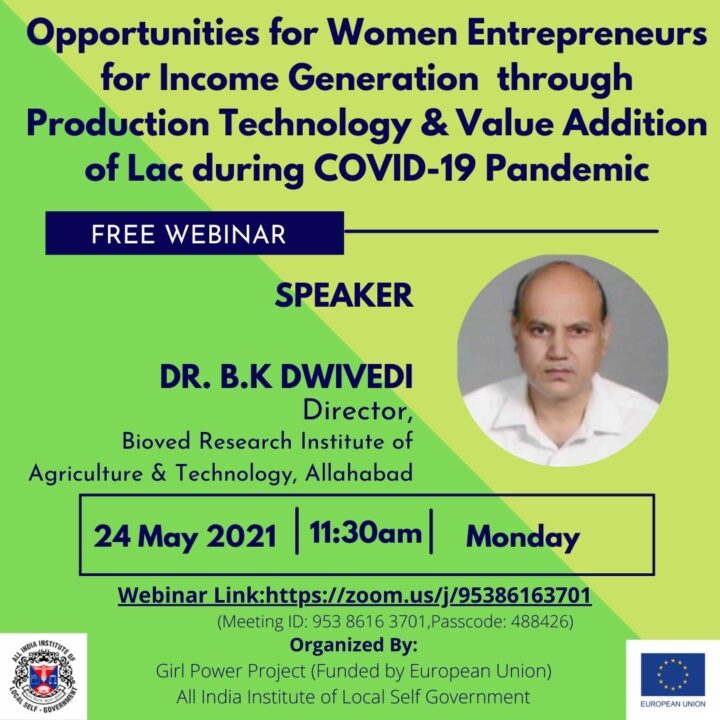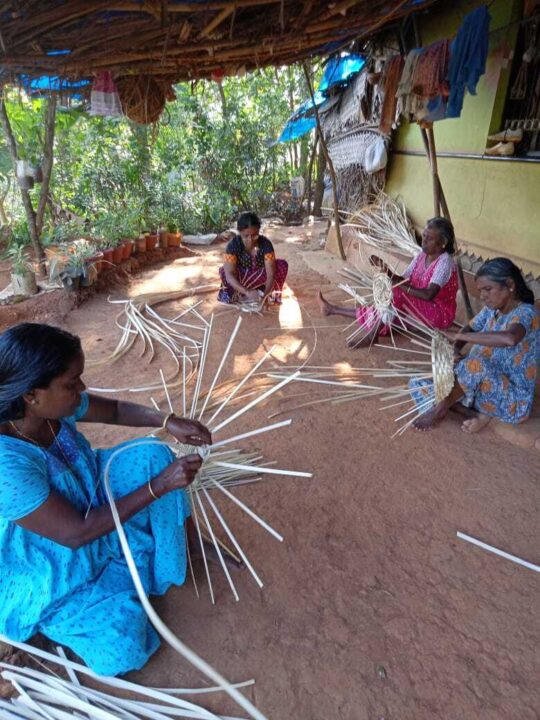Girl Power Project team has designed the Best Practice Forum , a platform to support and promote the knowledge sharing and best practices for the benefit of upcoming women entrepreneurs in Jharkhand.

One of the distinctive components of the Girl Power Project is the Best Practice Forum. This forum was included as the project activity, with the aim of capacitating and building women entrepreneurs by engaging in knowledge sharing and promoting diversity on various topics related to gender empowerment, skill building and social entrepreneurship promotion. Girl Power Project organized a Best Practice Forum on May 24 on lac production and value addition, which is one of the product identified through the Baseline Survey Study. Non-Timber Forest Products (NTFPs) play an important role in supporting rural livelihoods and food security in Jharkhand. The state is endowed with rich forest wealth. Out of a total geographical area of the country, Jharkhand accounts for
3.4 per cent of the total forest cover of the country and ranks 10th among all states. There is a voluminous list of NTFP in Jharkhand’s forests but important ones, which are mostly collected here and traded in high quality for livelihood supplements apart from agriculture are Tendu leaves, sal seed, mahua, tamarind, bamboo, and lac etc. In case of lac, Jharkhand alone contributes 57 per cent of the total produce which is widely exported.
Looking upon the prospects of lac cultivation in Jharkhand, a webinar was organized on “Opportunities for Women Entrepreneurs for Income Generation through Production Technology & Value Addition of Lac during COVID-19 pandemic” on May 24. The resource person for the webinar was Dr BK Dwivedi, Director of Bioved Research Institute of Agriculture & Technology, Prayagraj. It is pertinent to mention that Dr Dwivedi is extenesively involved in training and technology dessimination pertaining to lac production and value addtion.
During the webinar, the speaker also shared the works done on lac by the Bioved Research Institute of Agriculture & Technology. They went for value addition of lac in different products, training women and creating a platform for selling the produce. Some of the products on which they are working and are also exporting are lac laminated.
Lac cultivation: Lac is a natural resinous substance of profound economic importance in India. It is the only resin from animal origin lending itself to diverse applications like as a protective and decorative coating in the form of thin films, adhesives and plastics. The lac insects thrive on the sap of certain plants called lac hosts. Host plants are Palas, Ber, Kusum, Peepal, Akaasmani, Galwang, Flemingia and Gular. Two strains of the lac insects recognized in India are rangeeni and kusumi. Each strain completes its life cycle twice a year. Lac plays an important role in the economy of the country; 3-4 million tribal people who constitute the socioeconomically weakest section of the Indian population earn a subsidiary income from its cultivation. India is the major producer of lac, accounting for more than 50 per cent of the total world production. It virtually held a monopoly in lac trade during the period of First World War, producing nearly 90 per cent of the world’s total output. Today, an average of about
20-22 thousand tons of stick lac (raw lac) is produced in the country
every year.
Why lac cultivation: Lac is a good source of livelihood for poor farmers and ensures assured source of income during droughts. It requires meager inputs like water, pesticides etc., is most suitably grown on marginal and degraded land and poses no competition to other horticultural, agricultural crops for land and farm operation. It does not harm the host tree’s health, or that of other flora and fauna. It also avoids migration of rural population to urban areas and increases opportunities for women for better occupation and returns on investments.
Scope of lac based enterprises: Because of its unique combination of properties, lac finds a wide variety of applications in paint, electrical, automobile, cosmetic, adhesive, leather, wood finishing and other industries. Lac has long been in use for both decoration and lacquers of various kinds and insulating varnishes. It is usually used as a first coating on wood to fill the pores and also applied to seal knots likely to exude resin and disfigure or spoil finished paint work. Lac is used in manufacture of glazed paper, printing and water proofing inks, lac bangles, dry mounting tissue paper, dental plates and optical frames. It is also used as a coat for metal ware to prevent tarnishing, for finishing various products such as playing cards, oil cloth and linoleum, and for preserving archeological and zoological specimen.In the electrical industry, lac is used as coating of insulators and spark plugs, cement of sockets of electrical lamp, ant tracking insulating etc. In the pharmaceutical industry, lac is used in coating of tablets, micro-encapsulation of vitamins and coating of medicines. Lac dye is used in dying of wool and silk, soft drink formulation, pill coating, confectionary and chocolate coating. Lac wax has wide variety of uses in manufacturing shoe polishes, tailor’s chalk, lipstick, crayons (for writing in glass). Nowadays, it is also used in fruit coating. In short, there are tremendrious possibilities for establishing enterprieses by women entrepreneurs for their empowerment.
Key takeaways: In Jharkhand, the possible interventions for lac cultivating farmers can be done for enhancing income and turning them into entrepreneurs through promoting the lac cultivation on a larger scale by filling the knowledge gap through capacity building and exposure visits. If a woman farmer has lac host plants, then appropriate steps should be taken to mobilize them to take lac cultivation on all trees. If a producer does not have host trees, they can grow fast-growing host trees. At the village level, some of the women entrepreneurs can go for nursery business, wherein they can supply the lac insects for cultivation in their own village as well as
nearby villages.
Individual women entrepreneurs, or SHGs, can focus on manufacturing of value added products using lac. Possible linkages can be made through identifying the vendors for selling the raw produce as well as value added products. Promotions can be done of these products through various platforms to provide an opportunity for women entrepreneurs for their income as well as employment generation in this sector, making them financially secure and independent.

